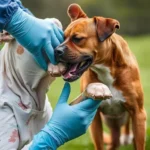
Introduction
Social aggression in dogs refers to aggressive behaviors exhibited by dogs towards other dogs or humans in social situations. This type of aggression can manifest as growling, barking, snapping, or even biting and often occurs during interactions that involve perceived threats or challenges to dominance. Addressing social aggression is crucial not only for the safety of other pets and people but also for the overall health and well-being of your dog. In this article, we will dive deep into understanding the nuances of social aggression, its causes, assessment methods, management strategies, preventive measures, and tips for living with a socially aggressive dog.
Understanding Social Aggression in Dogs
What is Social Aggression?
Social aggression is a complex behavior that can arise in various contexts, often related to social hierarchy and territorial disputes. Unlike fear aggression, which is a defensive reaction to perceived danger, or territorial aggression, which usually involves protecting a specific area, social aggression typically occurs in situations where dogs interact with one another or with humans. This type of aggression can stem from a variety of factors, including genetics, socialization experiences, and health issues.
Signs of Social Aggression
Recognizing social aggression in dogs is vital for early intervention. Common behaviors associated with this form of aggression include:
– Growling: A clear warning signal that your dog is uncomfortable.
– Barking: Excessive barking directed at other dogs or people can indicate aggressive tendencies.
– Snapping or lunging: Sudden movements toward other animals or humans may signify aggression.
– Stiff body posture: Dogs may appear tense and rigid when feeling threatened.
To effectively recognize these signs, observe your dog in various situations. Pay attention to their body language and the context of their interactions with other pets or people.
Causes of Social Aggression
Genetic Factors
Certain breeds may be predisposed to social aggression due to genetic traits. Breeds such as Rottweilers, Doberman Pinschers, and German Shepherds can exhibit more dominant behaviors, making them more likely to show aggression in social situations. Understanding your dog’s breed characteristics can help you anticipate and manage aggressive tendencies.
Environmental Influences
The environment plays a significant role in shaping a dog’s behavior. Early socialization experiences are critical; puppies that are not exposed to a variety of environments, people, and other dogs may develop social aggression as adults. Additionally, inadequate training or inconsistent discipline can reinforce aggressive behaviors rather than mitigate them.
Health Issues
Medical conditions can also contribute to social aggression. Pain or discomfort from health issues like arthritis, dental problems, or neurological disorders might cause a dog to react aggressively when approached. Regular veterinary check-ups are essential to rule out underlying health problems that may contribute to aggressive behavior.
Assessing Social Aggression in Your Dog
Behavioral Assessment Techniques
Assessing social aggression involves both observational methods and professional assessments. As a dog owner, you can start by observing your dog’s behaviors in various scenarios. Note their reactions to other dogs, new people, or unfamiliar environments. If you suspect significant aggression issues, consider consulting a professional dog trainer or behaviorist who can conduct a thorough assessment.
Identifying Triggers
Understanding what triggers your dog’s social aggression is essential for effective management. Common triggers may include:
– Other dogs: Aggressive behaviors may be directed toward unfamiliar or dominant dogs.
– Strangers: Some dogs may display aggression towards people they perceive as threats.
– Specific situations: Events such as crowded parks or loud environments can heighten aggression.
Keeping a behavioral diary can help you identify patterns and triggers. Note the circumstances surrounding aggressive incidents, including the location, the presence of other dogs or people, and your dog’s body language prior to the incident.
Management and Treatment Strategies
Training and Socialization
Early and ongoing training is vital in managing social aggression. Positive reinforcement methods, such as rewarding good behavior with treats or praise, can be particularly effective. Desensitization techniques, where a dog is gradually exposed to triggers in a controlled manner, can also help reduce aggressive responses over time.
Professional Help
If your dog’s social aggression is severe or unmanageable, seeking help from trained professionals is crucial. Look for certified dog trainers or behaviorists who specialize in aggression. They can offer personalized training programs tailored to your dog’s specific needs, including group classes that provide controlled socialization opportunities.
Behavioral Modification Techniques
Managing social aggression may involve behavioral modification techniques such as counter-conditioning. This technique involves changing your dog’s emotional response to a trigger by associating it with positive experiences. Consistency and patience are key in implementing these techniques, as behavior change can take time.
Preventive Measures
Socialization Opportunities
Providing your dog with various socialization opportunities is essential. Exposing them to different environments, people, and other dogs helps build confidence and reduces the likelihood of social aggression. Structured playdates with well-mannered dogs and enrolling in training classes can offer safe socialization experiences.
Regular Veterinary Care
Regular veterinary check-ups are important in preventing aggression linked to health issues. Keeping your dog up-to-date on vaccinations and parasite control can help maintain their overall health and reduce discomfort that may lead to aggressive behaviors.
Responsible Ownership Practices
Adopting responsible ownership practices is essential for managing social aggression. Proper leash handling and maintaining control in public spaces can prevent confrontations with other dogs or people. Educating yourself about dog behavior and recognizing the signs of stress or discomfort in your dog can further aid in preventing aggressive incidents.
Living with a Socially Aggressive Dog
Daily Management Strategies
Managing encounters with other dogs and people requires a proactive approach. Here are some tips for daily management:
– Avoid crowded areas: If your dog shows signs of aggression, steer clear of busy parks or events.
– Controlled introductions: When meeting new dogs, do so in a controlled environment and keep your dog on a leash.
– Create a safe environment: At home, provide a designated space where your dog can retreat when feeling overwhelmed.
Owner’s Mental Health
Owning a socially aggressive dog can be challenging, and it’s important for owners to prioritize their mental health. Joining support groups or online forums can provide a sense of community and offer valuable resources. Sharing experiences with other dog owners can help alleviate feelings of frustration or isolation.
Conclusion
Understanding and managing social aggression in dogs is vital for the safety and well-being of both the dog and those around them. By recognizing the signs, identifying triggers, and implementing appropriate training and management strategies, you can create a harmonious environment for your pet. Seeking professional help and staying informed about dog behavior will further enhance your ability to manage aggression effectively.
FAQs
What is the difference between social aggression and fear aggression in dogs?
Social aggression is primarily rooted in issues of dominance or social hierarchy, while fear aggression occurs when a dog feels threatened or scared. Understanding the underlying motivations for each type of aggression can help in determining appropriate management strategies.
Can social aggression be completely cured?
While some dogs may overcome social aggression through consistent training and socialization, others may always require careful management. The goal is to reduce aggressive behaviors and improve the dog’s overall quality of life.
Are certain breeds more prone to social aggression?
Yes, some breeds are genetically predisposed to exhibit dominant or aggressive behaviors. However, social aggression can be managed regardless of breed through proper training and socialization.
How can I tell if my dog is being socially aggressive?
Signs of social aggression include growling, snapping, lunging, and intense barking at other dogs or people. Observing your dog’s body language and reactions in social situations is crucial for identifying aggression.
When should I seek professional help for my dog’s aggression?
If your dog’s social aggression poses a risk to others or if you feel overwhelmed managing it on your own, seeking professional help from a certified trainer or behaviorist is recommended.









